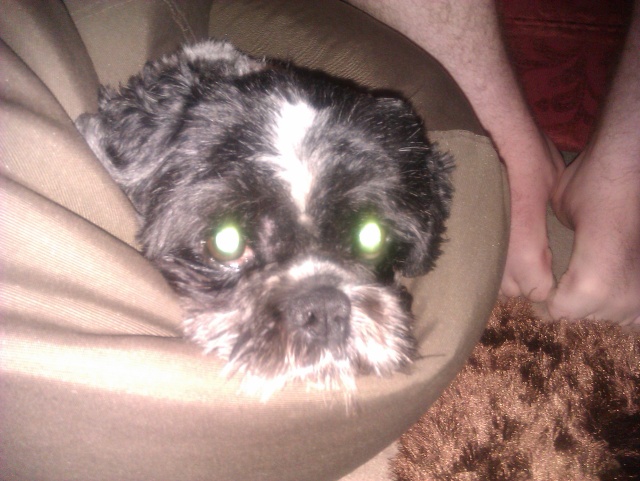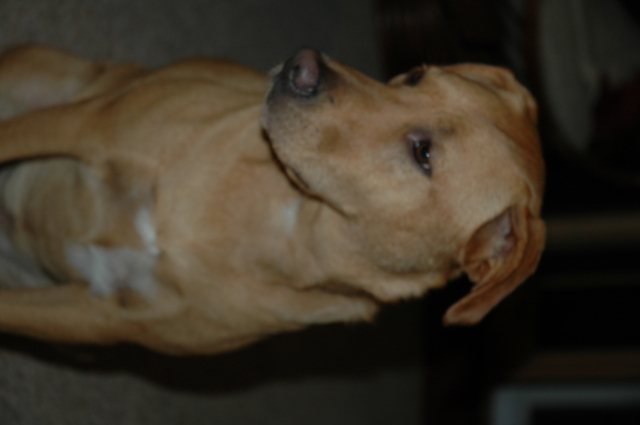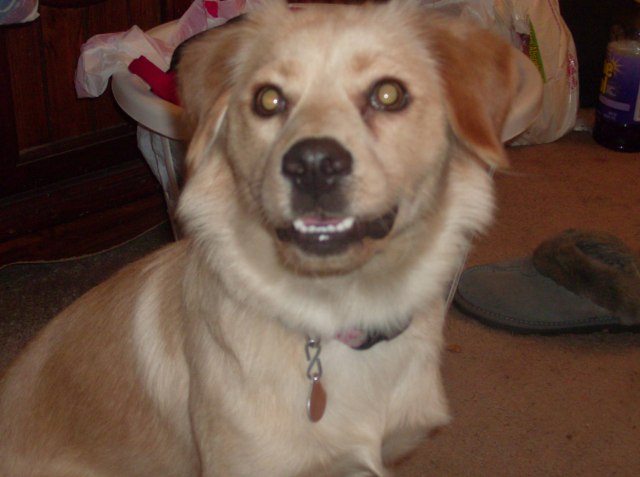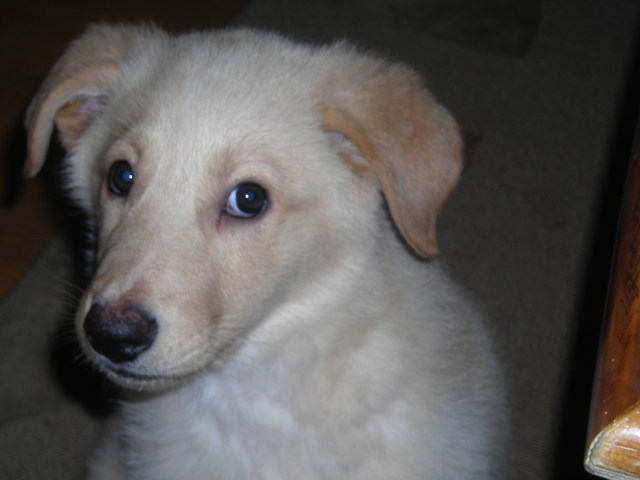QuestionWe have a new dog that we got from the pound about 6 weeks ago. He was an owner surrender. He's an 8-year-old small (17 pound) neutered mixed breed (supposedly Boston terrier-beagle, but I'm not sure about that). We have two other dogs. When we got Rocky he was overweight and had dirty teeth (we think he was fed table-scraps) and jumped up on furniture like he belonged there. Within a few days of owning him we got him a small bolster type bed (the other two dogs are larger and have their own beds) and he immediately took to it (we think he may have had a similar bed in his previous home). He's become protective of his bed. He will growl and snap at you if you approach him (even to pet him) while he is in his bed. We took his bed away for a few days and he was fine. Then we gave him his bed back and he's even worse now. What is going on? He's not food aggressive, even though he is a real chow hound, just bed-aggressive.
AnswerGreetings, and thank you for contacting All Experts,
First of all, thank you so much for opening your heart and home to a dog from the pound! Sounds like he was in a pretty bad shape and you are doing a wonderful job in taking care of him! Now, let's evaluate a bit the problem and see what can be done to make life easier for both of you. From your description it sounds like this little fellow has claimed his bed (you said that from the get-go he had little inhibition whatsoever on jumping on furniture like he belonged there). Since he will growl and snap at any attempt for you to get close it very likely sounds like he fits the profile of a resource guarder. A resource guarder is a dog who claims and perceives an item as his and feels threatened by any person on animal that comes too close.
Resource guarding is quite a popular tendency in the world of animals but if you think about it, as humans, we are also resource guarders. Just think how you would react if you are at a train station and would notice somebody suspicious coming near you trying to steal your wallet. What would you do? Very like you would scream, try to threaten the person away or even attack the person to stop him from getting your hard earned money. As humans, we are very strong resource guarders, indeed we fiercely protect our valuables by keeping them in safes, vaults or banks, and when threatened to lose them, we often feel compelled to attack the intruder attempting to deprive us from such valuables!
While most dogs resource guard food, your pooch is enamored with the bed and feels the need to protect it from a perceived threat. There are no black and white rules on what items a dog may perceive as valuable, rather this is subjective. For some dogs a bone is very valuable, for others it is a toy, and in your case it is the bed. In Rocky's eyes indeed the bed is more valuable than food. It could be that sleeping on the cold, hard floors of the shelter is ultimately what makes him appreciate the bed even more than anything else. To each its own!
Now, let's move on to how to deal with the problem. You claim you have tried to remove the bed and things got significantly better. Of course, with no bed to guard, the problem is easily solved. As much as this works, however, it does not go to the root of the problem and you may feel like you have wasted your money. Add on top of that that Rocky sure does deserve a bed of his own, so how can we find a compromise? I would give the below behavior modification program a try, but just be very careful; keep in mind that a growl and snap are warning signs telling you " if you get closer, I will bite". So please keep safety in mind and work the best you can work under the threshold. This program includes two behavior modification techniques: de-sensitization and counter-conditioning. Don't worry, you do not need to have a degree in behavior science to understand these, we will go over these terms in a bit.
Let's first understand what causes Rocky to act as he does. When a dog guards an item, being a bed, toy or food, it is because he perceives a threat. Basically, Rocky is terrorized of being deprived from his valuable possession; his bed. This is often a trust issue. It could be as we stated before that he never had a comfortable bed to sleep on or it could be that it is in his genetic makeup to be a bit possessive in nature. It could also be a learned behavior; if he growled to protect a valuable in the past and it worked to keep others away, a behavior pattern may have established. For instance, let's imagine every day you go to a crowded market to purchase food. Then one day a guy tries to rob your purse. You scream at the top of your lungs and this guy runs away. The day after you may be more wary of people around you. And if somebody tries to steal your purse again, I bet you will have a bigger plan in mind, you may have a cell phone ready to call the police or even a can of pepper spray!
So why did Rock's behavior exacerbate when you took the bed away? Very likely, because his biggest threat came true: you took the bed away and now he is even more insecure about it. But no need to worry much, as there is remedial work for this that may change things around. So let's take a look at the behavior science terms we mentioned earlier (threshold, desensitization and counter conditioning) so to have a better understanding of how we are going to try to work on the problem.
Definition of Threshold
We all have threshold levels. If you are dealing with a child that is nagging you to buy something and you don't want to give in, you may have a breaking point at which you will say "that's enough!" and even take the child out of the store. If you are scared of snakes and happen to walk through a jungle where there are snakes in bushes, you may have a breaking point at which you will start screaming and lose control. In the same way, dogs have breaking points when they are fearful, aggressive or excited.
When you are able to tolerate your child nagging for you to buy a toy, you are under the threshold or "sub-threshold". The word sub simply means "under". When you are no longer able to tolerate and lose your temper, then you are "over the threshold".
In a similar way, when you are far away from Rocky's bed, he may likely care less because he does not feel threatened. If you get closer you may be greeted by a growl and snap. When you are far he is "subthreshold", when you are near he is "over the threshold". I hope this makes sense.
Definition of Desensitization
Systematic desensitization is a behavior modification method used to work with dogs. This is mainly done under the threshold. The purpose of this is to decrease the emotional response to a negative stimulus after repeated exposure to it. With time and with gradual exposure animals and people tend to relax when they no longer perceive the stimulus as threat. So if for instance, you were taken to the jungle and saw snakes crawling at a distance every day, after some time, you may be able to relax because you may have learned that the snakes while slimy, are ultimately no threat to you.
Much caution must be used in using desensitization. If the exposure is too intense and over the threshold, you may obtain sensitization instead which means you get more afraid than before. So if you are say afraid of snakes and on the day after being exposed to them gradually, one slivers on you sandals, your fear may increase (you become sensitized instead of de-sensitized).
In the case of Rocky's bed you would therefore work on the problem from a distance so he is under the threshold and you do not pose a big threat to him.
Definition of Counter Conditioning
When counter conditioning is added to a desensitization program, the power doubles, it's like adding a cherry on top of a sundae. In counterconditioning, you are basically changing the dog's emotional response by shifting it upside down. So let's say you were scared of snakes, but every time you saw a snake you were given a $100 dollar bill; with time your emotional response towards snakes may change from fearing them to actually looking forward to them!
In the case of Rock'y bed you would therefore change his emotional response from "oh, no! better guard the bed before they take it away from me!" to "yes, owner come near me, you are soo welcome!"
So let's see what to do in a step by step guide:
For this exercise you will need high-value treats, not the average dog kibble or so-so dog treats. You need treats your dog drools for and that are very enticing. Freeze dried liver, slivers of hot dog, chunks of roasted chicken or steak, whatever your dog loves.
1)Find your dog's threshold level. When your dog is laying on the bed walk towards him from a safe distance and mark on the floor the distance at which he starts freezing or tensing up. You do not want to get to the point of where is growling. Place yourself a few inches BEFORE this marked zone from which he should feel relaxed. Remember we are working under the threshold and getting him systemically desensitized to our presence.
2) Walk back and forth a couple of times beyond this mark not towards him but parallel to him so to ensure you got this distance right. He should appear to OK with this distance. If at any time he seems to be stiffening, err on the side of caution and make the distance greater.
3)From this distance, walk parallel and start tossing treats his way. You should try to aim at his dog bed since he may be unlikely to leave it if he is not too much food motivated. Do this four or five times repeatedly during the day.
4)The next day, work again from this distance again, if he seems OK with it,then mark a closer distance just a few inches closer. Do the same exercise, walk parallel (dogs see us less intimidating when we walk parallel than towards them) and toss the treats as you pass by him. Repeat, repeat, repeat.
5) Continue with the exercise, and decrease the distance gradually day after the day. If he growls at any time, freeze. Don't leave; if you do you will reinforce the growl (remember the growling is a learned behavior and leaving reinforces the growl, in the dog's mind "I sent him away!". The moment he stops growling toss the treat.
6) At some point you may be near the bed. At this point, try to give a big reward for this. A jackpot of treats (a handful of tasty treats all at once)will make his day. Repeat, repeat, repeat. You should start seeing results at this time: perhaps a little hint of a tail wag as you get close or anticipation (drooling, looking for the treat). This is good news and means the training is working! This is the power of counter-conditioning, the dog is saying "I no longer fear you are taking my bed away, I look forward to you coming near my bed!"
7) If you are satisfied with the results you can keep up the training up by doing refreshers every now and then, where yo casually walk by and give a tasty treat.
*Note: any time a dog has behaved in a certain way for a long time you should expect extinction bursts. What are these? Extinction bursts are a worsening of the original behavior. They may seem like a set back, but in reality they are sign the training is working. In other words, yo may see Rocky growling more at some point. What is happening is Rocky is saying "HEY! I am growling, see my pearly whites! I am saying go away! You usually go away, but for some reason my behavior is not enough to send you away today, maybe I need to intensify the behavior for you to understand". Ignore it. Don't advance and don't go away. Just freeze, stay there and ignore. Then toss a treat the moment he stops growling. Behaviors that are rewarded establish, whereas, behaviors that are not rewarded extinguish. As opportunistic beings, dogs learn quickly which behaviors are more advantageous!
While I am at it, I also would like to share the "learn to earn" training program that helps with newly adopted dogs and gives them a routine:
http://alexadry.hubpages.com/hub/How-to-Train-Dogs-Nothing-in-Life-is-Free-Say-P
Sorry this turned out lengthy! I just wanted to make sure you understood how it all works. I hope it helps, thanks again for taking care of this boy. Please take a moment to rate my answer when you have a chance, my very best wishes!
Adrienne Farricelli CPDT-KA
Disclaimer: Please consult with a dog behaviorist if your dog is displaying aggressive behaviors. Only a dog behaviorist may see and assess behaviors and offer the most appropriate behavior modification program tailored for your dog. Use extreme caution and make safety your top priority. By reading this answer you accept this disclaimer and assume full responsibility for any of your actions.

 Puppy Yelping
QuestionQUESTION: Hi! I have a 6 month old Cocker
Puppy Yelping
QuestionQUESTION: Hi! I have a 6 month old Cocker
 having problems with toilet training
Question
Oscar
hello
A friend of ours dog, Oscar is a 5
having problems with toilet training
Question
Oscar
hello
A friend of ours dog, Oscar is a 5
 dog distraction/deer carcass
Question
ginger
Our dog is a mutt mostly Rhodesian Ridg
dog distraction/deer carcass
Question
ginger
Our dog is a mutt mostly Rhodesian Ridg
 Running/Non-Obeying
Question
Star
I have a female Lab mix who has this obse
Running/Non-Obeying
Question
Star
I have a female Lab mix who has this obse
 housetraining
QuestionQUESTION: We have a 10 week old retriever/colli
housetraining
QuestionQUESTION: We have a 10 week old retriever/colli